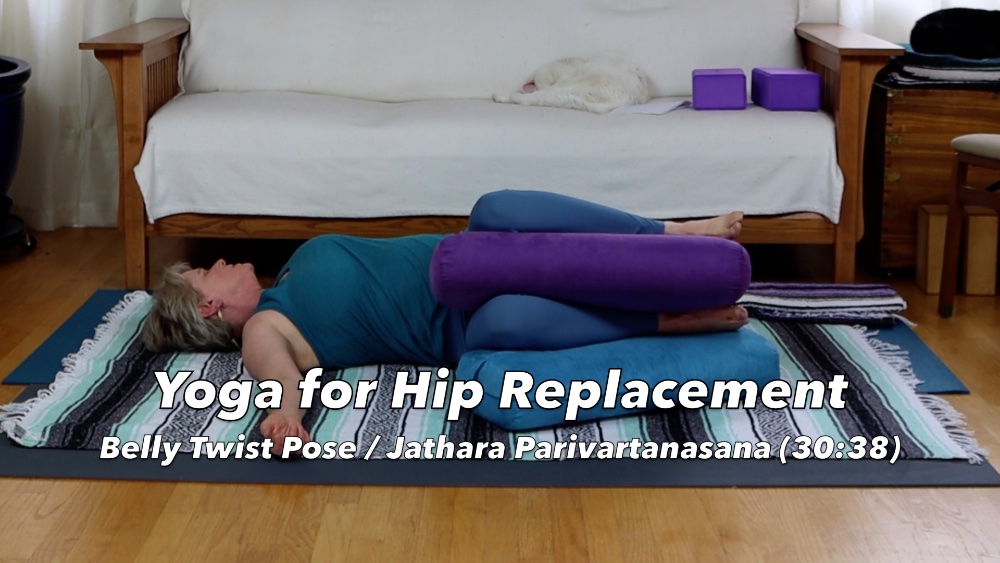Restorative Poses
Restorative Poses to relax, balance, and heal
Practicing Restorative Poses encourages physical, mental, and emotional relaxation which has multiple benefits for our body’s systems and which are especially important while preparing for or recovering from surgeries like THR. Restorative Poses activate the Parasympathetic Nervous System, that aspect of our Autonomic Nervous System related to “resting” and “digesting.” When we “restore,” we promote healing, build a resiliency to stress and pain, and help bring balance to the whole system. Because of their gentle nature, certain Restorative Poses, like Corpse Pose, or Reclining Bound Angle Pose, can be practiced in the days following THR surgery when healing is your main job, and before post-surgery restrictions have been lifted by your surgeon.
Read More
In Restorative yoga we hold poses for longer periods while focusing on the breath and on relaxing. Learn a variety of ways to use props to make each pose comfortable.
- Relax your mind and body.
- Soothe the nervous system.
- Enhance your mood.
- Reduce chronic pain.
- Improve sleep.
- Improve well-being.
- Be gentle on your body.
Restorative Poses work as part of an overall treatment plan for healing and managing pain related to THR.
Video Previews
Corpse Pose / Savasana Preview
Video length: 23:50
Props: Floor: 1 yoga mat, 2 blankets, 1 bolster. Couch, relciner, or bed: 2 blankets, 1-2 bolsters.
Access: 1-Week Free Trial & Members
Corpse Pose is the most common restorative for the end of an asana class. It is also a beneficial and safe pose to practice following surgery and before post-surgery restrictions are lifted. In a typical yoga class we practice active poses which strengthen, stretch, and invigorate our body, nervous system, and mind. Restorative poses like Corpse Pose have an opposite effect by calming and soothing the whole system. The balance of active and restful postures builds our resiliency for coping with pain and with stressors that come with surgeries like THR.
Read More
- Warm-up with gentle movement either on the floor or in a chair.
- Learn how to position your body on the floor or on a couch.
- See how to use props.
- Practice intentional relaxation for body, nervous system, and mind.
Corpse Pose and other restoratives are beneficial for any yoga practice but essential for THR!
Suggested viewing:
Reclining Bound Angle Pose / Supta Baddha Konasana Preview
Video length: 30:36
Props: Floor: 1 yoga mat, 2 blankets, 2 blocks, 2-3 bolsters. Couch, recliner, or bed: 2 blankets, 2-3 bolsters.
Suggested viewing: Savasana
Access: 1-Week Free Trial & Members
Reclined Bound Angle Pose is another restorative that can be practice safely after hip surgery and before post-surgery restrictions have been lifted. One of its main benefits for THR is that it keeps the inner thigh muscles (adductors) supple which is helpful because leg muscles, in general, tend to shorten following surgery.*
Read More
- Learn ways to set-up for the pose
- See how to use props
- Practice relaxing in Supta Baddha Konasana
Supported Bridge Pose / Supported Setu Bandhasana Preview
Video length: 26:26
Props: Floor: 1 yoga mat, 1 blanket, 1 block. Couch, recliner, or bed: 1 blanket, 1 block.
Suggested viewing: Savasana
Access: Members
The journey through THR can create tension in our muscles. Among them are hip flexors, which can tighten as they try to protect a failing joint or in response to Anterior Approach Surgery, and shoulder muscles which can be tense in response to stress. Supported Bridge targets those muscles by stretching them and releasing tension while at the same time offering the relaxing benefits of an inversion.
Read More
- See ways to set up with blocks and straps
- Enjoy a guided relaxation in the pose.
Child’s Pose / Balasana Preview
Video length: 27:33
Props: 1 mat, 2 chairs, 2 blocks, 2 blankets, a bolster or sturdy cushion.
Suggested viewing: Savasana/Corpse Pose
Access: Members
Child’s Pose, like other restorative postures, is not only relaxing but it also supports healing and builds resiliency to pain and stress. It sends massages to internal organs which help digestion and constipation and tones the diaphragm which keeps us breathing well. In addition, because of the gentle pressure it brings to the belly, this posture stimulates the Vagus nerve, a nerve associated with the Parasympathetic Nervous System, that aspect of the Autonomic Nervous System that is associated with resting, digesting, and healing – all supportive of the THR journey.
Read More
- See how to set-up using chairs and the floor.
- Explore ways to use props to make it very comfortable.
- Practice relaxing in Child’s Pose following the set-up.
More Titles in Restorative Poses

Belly Twist Pose / Jathara Parivartanasana (30:45)
Access: 1-Week Free Trial & Members
Give your belly and internal organs a nice massage while at the same time stimulating the Vagus nerve. Vagus means “wandering” and is an apt name because this nerve threads its way around our internal organs and sends messages to our brain that are responsible for our “gut feelings.” When stimulated it activates our Parasympathetic Nervous System and helps us relax – a necessity for anyone dealing with the stressors of THR!!
